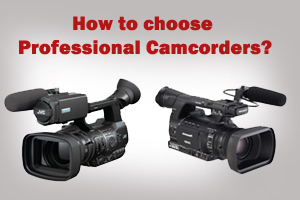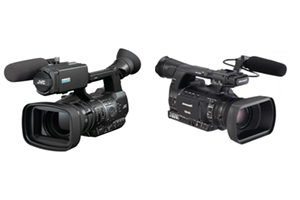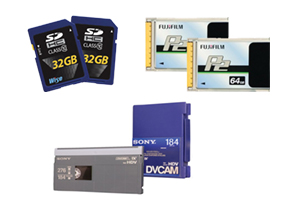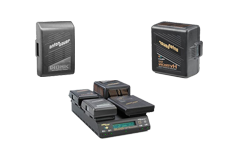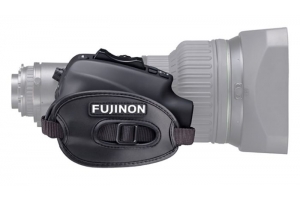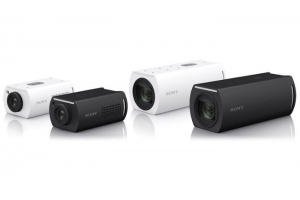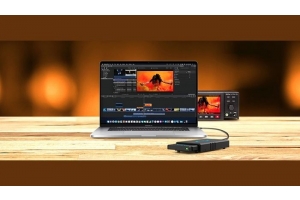Ultimate Guide to Professional Camcorders
How to pick a Professional Camcorder
The term “ professional camcoders ” is very subjective term. As technology continually improves, the line in quality between consumer cameras and professional camcorders gets increasingly thin. But as any serious filmmaker/videographer will tell you, the jump to a professional level camcorder comes with huge improvement in the amount of control over your image. To make things more confusing, the word “prosumer” has popped up as a halfway between the consumer and professional realm. For the purposes of this article, we will consider professional camcorder as cameras with 1/4″ chips sizes and up (more on chip size later).
When considering a professional camcorders, skip the beauty reels that you’ve seen on YouTube and Vimeo. Yes we’ve all seen the beauty videos with the rolling tree tops and the steel jungles. They’re fun to watch but they say more about the producer than the camera. After all, you can point any half way decent camera at a beautiful flower and capture a beautiful image. Beyond that, the fact is, all video hosting sites heavily compress their videos. Judging the capabilities of a camera based on compressed and resized web video will not give an accurate comparison of the cameras. Instead, you want focus of the features that will work for your film or video business.
THE BASICS
If you’re planning on investing in a professional camcorder, the camcorder must be at least capable of HD.
HD comes in a variety of flavors (HDV, XDCAM HD, P2, DVCPRO HD), which you must consider when you purchase a camera, but any Professional HD Camcorder, given the proper framing and lighting, will yield a better image than an similarly priced SD camcorder.
If you feel like you’re not ready to take the plunge into HD quite yet (for any reason), look around in the used market for a professional SD camcorder. There are plenty of them floating around as the market moves towards HD.
Keep in mind also, that many HDV camcorders are also capable of recording in Standard Definition (SD) DV or outputting an HD signal to SD. So even if the rest of your workflow isn’t ready for HD, you can still shoot HD and down convert to SD as needed.
Being that the camcorder is HD, you will be shooting in the 16×9 widescreen format. Make sure the camcorder shoots in the regional format that you want to deliver in (i.e. NTSC and PAL).
If you want to produce a more “film like” experience (another loaded term for a different article), make sure the camcorder has a 24p option. Be sure to research the 24p system that your camcorder uses – every brand seems to perform the 24p acrobatics in different ways. Consider the capabilities of your Editing software as well.
CHIP SIZE
Almost all lower to medium end professional hd camcorders have a 1/3″ imaging chip. Some of the smaller guerilla type professional hd camcorders sport a smaller 1/4″ chip.
As you step up in chip size to 1/2″ to 2/3″ and even to the full 35mm styled chips (as in the RED), you will see an improvement in low light performance and substantially greater Depth of Field. The downside is these larger chips will be substantially more expensive. Generally speaking, the larger the chip, the better the image quality.
CCD VS. CMOS
The professional hd amcorder industry is currently in a transitional state between CCD style imaging chips and CMOS style imaging chips although CCD camcorders will be around for the foreseeable future. The difference between the two technologies is significant but goes way beyond the scope of this article. Both types are capable of producing great images but both have their drawbacks.
There is one major drawback to CMOS camcorders that worth noting in this article. CMOS camcorders use Rolling Shutters which can result in some unpleasant motion flaws in extreme situations – such as a whip pan. These flaws include: skew, wobble and partial exposure. These are problems in all CMOS camcorders, but with the proper handling, can be avoided.
3 CCD / 3 CMOS
This is a term you’ll see thrown about a lot with these professional camcorders. The concept involves splitting an image into its color components (Red, Green, and Blue) and recording them separately. Generally speaking in CCD camcorders, having 3 chips is the prerequisite for a “professional” level camcorder. Because CMOS functions differently, many camcorders (including the RED) only require 1 CMOS chip.
INTERCHANGEABLE OR FIXED LENS
For many professionals, this is the number one deciding factor when investing in a camcorder.
Camcorders with interchangeable lenses allow you to swap out the lens for a different one. Although most camcorders with an interchangeable lens come with a stock hd lens, there are a myriad of very high quality ENG (Electronic News Gathering) Lenses and Cine Lenses that you buy or rent to get achieve different focal lengths.
Camcorders with fixed lenses tend to be less expensive and lighter. Although you cannot change the lens on a fixed lens camcorder, there are wide angle lens and telephoto adapters that can be attached on the front of the camcorder.
LOW LIGHT CAPABILITY
If you plan on using your camcorder to shoot events where you can’t control the lighting, low light capability is something you’ll want to have. Similarly, if you want to use a DOF adapter (which we’ll discuss later), low light capability will be to your advantage.
The good news is most professional hd camcorders these days have excellent low light capabilities. Generally speaking, the larger the chip size and optics, the better low light response ie. a camcorder that has 1/3″ chip will perform better than a 1/4″ chip..
The bad news is there is no industry standard for defining low light performance. Every manufacturer will define a camcorder’s minimum illumination differently and often times that minimum illumination is defined using a whole host of “light enhancing” electronic features like gain and frame accumulation which will add noise and motion artifacting that is unwanted all but the most critical situations.
You may be able to use a manufacturer’s minimum illumination specs to compare the manufacturer’s camcorders to each other. But for overall comparisons, search for independent comparisons and go with the general rule of thumb – the larger the chip size, the better the low light performance.
TAPE OR TAPELESS
More and more professional camcorders manufacturers are offering tapeless camcorder options and it is becoming something worth considering when purchasing an hd camcorder.
Tape offers the advantage of being a simple, inexpensive, and well defined format. Archiving is simple – just pull the record inhibit tab on the tape and store in a cool dry environment away from light. Also if you’re in a collaborative environment, it’s easy just to hand off a tape to someone else. But tape is limited to a set bit rate so you are stuck with the limitation of the format (currently HDV).
Tapeless acquisition allows for much higher bit rates and opens the door to much higher quality video recording. The freedom from set bit rates also allows interesting camcorder options such as over-cranking and time lapse recording. The two major drawbacks to tapeless are the high cost of recording media and the fact that you will have to actively back up and archive footage on a hard drive in order to reuse your recording media. Some of the recording media are Wise Memory Cards,Sony Tapes,Fujifilm P2 cards etc.
Bar none, the best kind of audio connection for microphones is XLR. Most professional hd camcorders have XLR connections, but there are a few out there that use RCA which means you’ll need an external converter for your XLR microphones.
ERGONOMICS
Keep in mind how you will be using your camcorder for your production. If you intend on using the camcorder for event/corporate work, you may want to consider shoulder mount camcorders – something that will allow you to get steady shots even while handheld.
If you want to use a smaller camcorder stabilizer, you may want to opt for the smaller light weight camcorder. Similarly, if you intended to shoot a lot of guerrilla shots, you will want a smaller more inconspicuous camcorder.
If you happen to be used to a particular brand’s button layout, you will mostly likely want to stick with that brand as different manufactures all have their own layouts.
And of course, the “cool factor” does play into it as well. A big hulking camcorder with wires and blinking buttons looks great and can impress a client. But it’s also can be intimidating, requires a lot of set up time, addition people to operate (such as a focus puller) and is impossible to pull off a guerrilla shoot.
VIEWFINDER/LCD
Not all viewfinders are born equal. Although a viewfinder does not affect the final output of a camcorder, they make for easier critical focus and a generally more pleasant shooting experience.
Unfortunately, manufacturers are not exactly upfront about the specs of their LCD Monitors/Viewfinders. Most manufacturers supply a size; some will even give you a pixel count. The more pixels in an LCD, the cleaner and sharper the image.
Ultimately, the best way to judge a viewfinder is to compare models first hand.
VIDEO OUT
You can forgo the viewfinder if you are planning to send the video to a monitor through video out. All professional hd camcorders have video out. The video out connections can include: SDI/HD-SDI (highest professional quality SD and HD), HDMI, Component (HD and SD), S-Video (SD only), and Composite (consumer grade SD).
Make sure the camcorder you are purchasing has the same format as the Camera monitor you are intending to use.
Video Out can also be used to send the video to a Digital Disk Recorder such as the AJA KiPro. On some camcorders, the SDI connections actually send the video image out before the signal is compressed to the recording format (generally HDV). Sending the signal before the camcorder’s recording compression allows for better quality which can make color correction and green screen compositing easier in post-production. If you intend on using these devices, keep the video out options in mind when selecting a camcorder.
TIMECODE / GENLOCK
If you intend on using your camcorder in a multicam studio situation, you will need a camcorder with Time code/Genlock sync capabilities.
This may not be a concern if you are stepping up to your first professional camcorder. But if you are buying a second one, consider the type of battery the camcorder uses and how that will play into your budget. AntonBauer Batteries are the most reliable in market today. Some of them are Dionic 90,Hytron 140,Dionic HCX etc.
DEPTH OF FIELD ADAPTERS
One of the more exciting tools for the independent filmmaker of the last few years has been the advent and the improvement of the Depth of Field Adapter. Then adapters allow you to use 35mm lenses (still photo or film lenses) with your camcorder. When considering buying a camcorder, it’s worth considering if and how you will use it with a DOF Adapter.
A Depth of Field Adapter, also called a 35mm Adapter, works essentially like a projection screen. The image passes through the lens, and is projected on a translucent screen – the camcorder takes a picture of the screen. Since the area of the translucent screen is much larger than the image sensor, Depth of Field Adapters is capable of much shallower depth of field than the camcorder alone.
There are several limitations when using a depth of field adapter that you should consider in conjunction with your camcorder purchase. All Depth of Field Adapters project an upside down image on their translucent screen. Several DOF Adapter manufacturers offer image flipping devices, otherwise a camcorder with a viewfinder flip option would be useful. DOF adapters also eat of a lot of light, so camcorders with low light capabilities fare best with DOF adapters.Redrock Micro is the popular manufacturers of DOF Adapters
POPULAR CAMCORDER MODELS
Here is a selection of professional level camcorders. This is certainly by no means an exhaustive list of professional hd camcorders that are available on the market. Panasonic HD Camcorders,JVC HD Camcorders,BlackMagic Cinema camera, Sony camcorders etc. are the popular professional hd camcorders available in market today.
WHERE TO BUY?
When investing in professional camcorders, cost is certainly an issue. The interwebs are full of companies saying the offer “low prices.” But, is saving a couple dollars’ worth not having professional support for the huge number of questions you will have before AND after buying that camcorder? With a sales staff made up of working professional filmmakers and videographers with years of field experience, StreamPort Media is the only distributor we recommend (they also have some of the lowest prices). Don’t take our word for it, just ask around.
Visit the StreamPort Media Website
Tags:Professional HD Camcorders Dubai UAE,JVC HD Camcorders Dubai,Panasonic Camcorders Dubai,AntonBauer Batteries Dubai,Camcorder Batteries Dubai,Sony Tapes,P2 Cards,Professional Video Equipment Distributor Dubai,Broadcast Equipment Distributor Dubai.

 Arabic (UAE)
Arabic (UAE) 
